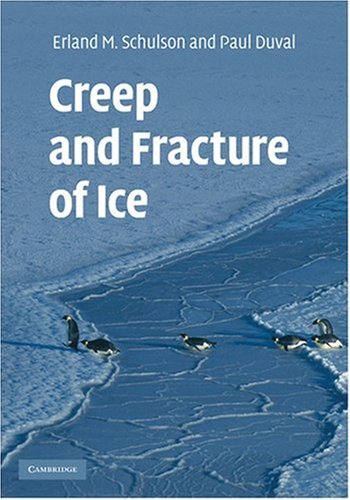Erland M. Schulson, Paul Duval0521806208, 9780521806206, 9780511540752
Table of contents :
Cover……Page 1
Title……Page 5
Half-title……Page 3
Copyright……Page 6
Dedication……Page 7
Contents……Page 9
Preface……Page 13
Acknowledgements……Page 14
1 Introduction……Page 17
References……Page 20
2.1 Introduction……Page 21
2.2.1 Unit cell and molecular stacking……Page 22
2.2.2 Lattice parameters, thermal expansion and density……Page 23
2.2.4 Physical characteristics……Page 25
2.3.2 Interstitials……Page 26
2.3.4 Ionic and Bjerrum defects……Page 27
2.4.1 Basic concepts……Page 28
2.4.2 Dislocations and slip systems in ice Ih……Page 33
2.4.3 Dissociation of basal dislocations into partials and stacking faults……Page 34
2.4.4 Non-basal dislocations……Page 36
2.4.5 Observation of dislocations……Page 37
2.5.1 Grain boundaries……Page 38
2.5.2 Free surfaces……Page 39
2.6 Volumetric defects……Page 40
Appendix A Miller–Bravais indices for hexagonal crystals……Page 41
References……Page 42
3.1 Introduction……Page 46
3.2 Experimental techniques……Page 47
3.2.3 Scanning electron microscopy (SEM)……Page 48
3.2.5 Electron back-scatter diffraction (EBSD)……Page 50
3.3.1 Sintering and densification of snow……Page 52
3.3.3 Bubbly ice and air-hydrate crystals……Page 53
3.4.1 Nucleation and early stage of development……Page 55
3.4.2 Growth……Page 56
3.4.3 Sea ice growth……Page 57
3.5 Terminology and classification……Page 61
3.6 Summary……Page 62
References……Page 63
4.2 Elastic properties of ice Ih single crystals……Page 67
4.2.1 Fundamental elastic constants……Page 68
4.2.2 Numerical values of fundamental constants……Page 70
4.2.3 Young’s modulus and torsional modulus……Page 72
4.3 Elastic properties of polycrystals……Page 73
4.3.2 Polycrystals with growth textures……Page 74
4.3.4 Sea ice……Page 78
4.3.6 Cracked/damaged polycrystals……Page 80
4.4.1 Characteristics……Page 83
4.4.2 Kinetic coefficient of friction……Page 84
4.5.1 Self-diffusion……Page 86
4.5.3 Diffusion of acids……Page 88
References……Page 89
5.1 Introduction……Page 93
5.2.1 Basal slip……Page 94
The effect of impurities……Page 96
Internal friction measurements……Page 98
5.2.2 Non-basal slip……Page 99
5.2.3 The flow law for basal slip……Page 100
Experimental measurements of dislocation velocity……Page 102
Rate-limiting processes for dislocation motion……Page 103
Cross-slip of screw dislocations……Page 105
5.3.2 Collective motion of dislocations and dislocation patterns……Page 106
Scale invariance of slip patterns in ice crystals deformed in torsion……Page 108
5.4 Rate-controlling processes for basal slip……Page 110
5.5 Conclusions……Page 112
References……Page 113
6.1 Introduction……Page 117
6.2 Deformation behavior of isotropic granular ice……Page 118
6.2.1 Creep tests……Page 119
Primary creep……Page 120
Secondary creep……Page 125
Tertiary creep……Page 131
6.2.2 Deformation at constant strain rate……Page 134
6.3 Deformation of columnar ice……Page 135
6.4.1 Secondary creep with nthinsp = 3……Page 138
6.4.2 Secondary creep with………Page 140
Intracrystalline slip accommodated by grain boundary migration (GBM)……Page 143
6.4.3 Rate-controlling processes for tertiary creep……Page 145
6.5.1 Grain growth in polar ice sheets……Page 146
6.5.2 Rotation recrystallization in glaciers and ice sheets……Page 150
6.5.3 Migration recrystallization in glaciers and ice sheets……Page 151
6.5.4 Energetics of dynamic recrystallization……Page 152
6.5.5 The nucleation of recrystallization……Page 153
Nucleation of grains in ice containing dispersed particles……Page 154
6.6.1 Deformation textures……Page 155
6.6.2 Recrystallization textures……Page 156
References……Page 160
7.1 Introduction……Page 169
7.2 Modeling the behavior of isotropic and anisotropic ice……Page 170
7.2.1 The viscoplastic self-consistent (VPSC) tangent approach……Page 171
7.2.2 The second-order self-consistent and fast Fourier transform (FFT) models……Page 175
7.4 Modeling transient creep……Page 176
7.5 Modeling viscoplastic behavior of columnar ice with the FFT model……Page 178
7.6.1 Description and strength of the texture……Page 181
7.6.2 Texture development……Page 184
Comparison with textures in polar ice sheets……Page 187
7.7 Modeling mechanical behavior of anisotropic ice……Page 188
7.8 Modeling with self-consistent models……Page 189
References……Page 191
8.1 Introduction……Page 195
8.2 Experimental methods……Page 197
8.3 Viscoplasticity of ice II and III……Page 198
Grain-size dependent behavior……Page 199
8.5 Comparison of ices……Page 200
8.6 Flow of methane clathrate hydrates……Page 201
8.7 Flow of ice in the ammonia–water system……Page 202
8.8 Conclusions……Page 203
References……Page 204
9.2.1 Griffith’s energy-balance concept……Page 206
9.2.2 Crack-extension force……Page 208
9.2.4 Crack-tip stress state under mode-I loading……Page 209
9.2.6 Stable versus unstable crack propagation……Page 211
9.3.1 Valid measurement of KIc……Page 212
9.3.2 Methods employed……Page 214
9.4.1 Temperature……Page 215
9.4.2 Grain size……Page 216
9.4.4 Porosity……Page 217
9.4.5 Particulates and fibers……Page 218
9.4.8 Size……Page 219
9.5 The role of surface energy……Page 221
9.6 Fracture toughness of snow……Page 222
9.7 Comparison with other materials……Page 223
References……Page 224
10.1 Introduction……Page 228
10.2 Methods of measurement……Page 229
10.3 Single crystals……Page 230
10.4 Polycrystals……Page 231
10.4.1 Temperature……Page 232
10.4.2 Strain rate……Page 233
10.4.3 Grain size……Page 234
10.4.5 Growth texture……Page 238
10.4.6 Brine pockets, brine-drainage channels and porosity……Page 239
10.4.7 Size……Page 241
10.5 Ductile-to-brittle transition……Page 242
10.6 Strength-limiting mechanisms……Page 243
Crack-propagation control……Page 244
Crack nucleation control……Page 245
10.6.4 Dynamic strength……Page 247
References……Page 248
11.1 Introduction……Page 252
11.2 Measurement of brittle compressive strength……Page 253
11.3 Ductile versus brittle behavior: an overview……Page 255
11.4 Single crystals……Page 257
11.5.1 Strain rate……Page 259
11.5.2 Temperature……Page 261
11.5.3 Crystallographic growth texture……Page 262
11.5.5 Porosity/salinity……Page 263
11.5.7 Cyclic loading……Page 265
11.5.8 Size and boundary conditions……Page 266
11.6 Failure process……Page 267
11.7 Wing-crack mechanics……Page 274
11.8 Strength-limiting mechanism……Page 277
References……Page 278
12.1 Introduction……Page 282
12.2 Experimental methods……Page 283
12.3.2 Triaxial loading……Page 286
12.4 Columnar ice……Page 289
12.4.1 Biaxial loading……Page 290
12.4.2 Triaxial loading……Page 296
12.5 Failure surfaces……Page 302
12.6 Relationship between compressive fracture and friction……Page 305
12.7.1 Adiabatic heating……Page 307
12.7.2 Implications……Page 308
12.8 Nature of Coulombic shear faults……Page 309
12.8.2 Wing cracks and comb cracks……Page 310
12.8.3 Comb-crack mechanics……Page 316
12.9 Nature of spalling……Page 320
12.10 Post-terminal failure of faulted ice……Page 324
12.10.2 Failure envelope of faulted ice……Page 325
12.10.4 Interpretation……Page 327
12.10.5 Non-linear friction?……Page 329
References……Page 330
13.2 Competition between creep and fracture……Page 336
13.3 Micromechanical model……Page 337
13.4 Comparison with experiment……Page 341
13.5 Dirty ice……Page 346
13.6 Application to rocks and minerals……Page 347
References……Page 349
14.1 Introduction……Page 352
14.2.1 Characteristics……Page 353
14.2.2 Origin……Page 356
14.3.1 Edge-loaded plates……Page 358
14.3.2 Indented walls……Page 361
14.5.1 Observations……Page 365
14.5.2 Explanations of the pressure–area relationship……Page 368
14.6 Impact failure……Page 371
References……Page 373
15.1 Introduction……Page 377
15.2.1 Observations and interpretation……Page 379
15.2.2 Mechanism of fault initiation……Page 385
15.2.3 Summary and further analysis……Page 389
15.3 Rheological behavior of the winter ice cover: friction and fracture……Page 392
15.3.1 Nested failure envelopes……Page 393
15.3.2 Stress versus strain rate……Page 397
15.3.3 Another case: scaling laws……Page 400
15.5 Is the physics of fracture independent of scale?……Page 402
References……Page 403
Index……Page 407

Reviews
There are no reviews yet.